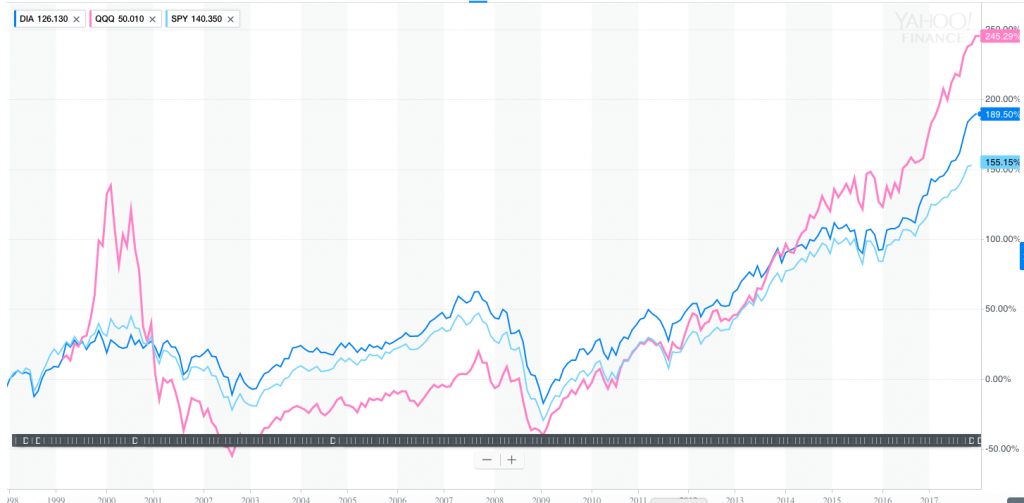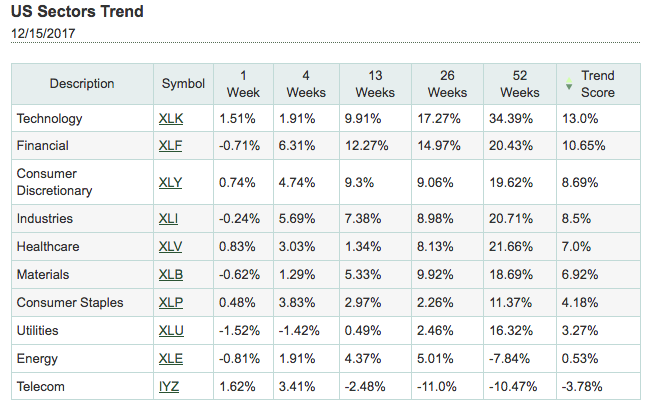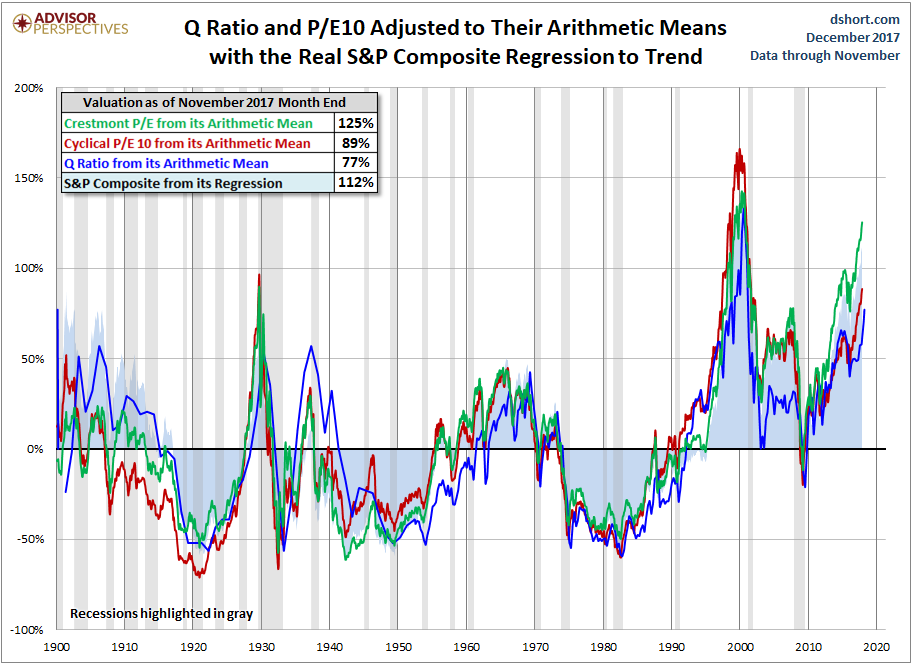Re-balance Cycle Reminder All MyPlanIQ’s newsletters are archived here.
For regular SAA and TAA portfolios, the next re-balance will be on Monday, January 22, 2017. You can also find the re-balance calendar for 2017 on ‘Dashboard‘ page once you log in.
As a reminder to expert users: advanced portfolios are still re-balanced based on their original re-balance schedules and they are not the same as those used in Strategic and Tactical Asset Allocation (SAA and TAA) portfolios of a plan.
Please note that we now list the next re-balance date on every portfolio page.
Happy Holidays!
In this holiday season, we thank everyone for your continuous support and your trust in us. We wish you happy holidays and a prosperous 2018!
There will be no newsletters in the following two weeks and we will return in the week of January 8th, 2018.
Record Highs And Risk
It’s been an almost perfect year for stocks. Dow Jones industrial index has had 70 daily record highs this year. Stock volatility is also staying in record low: CBOE VIX index has been the lowest since 1990. Looking more closely:
US stocks:
In fact, the rise of these US stock indexes this year has been parabolic and exponential.
Furthermore, the major asset classes are in a classic goldilock situation: long term bonds, high yield bonds, domestic and foreign stocks are all doing very well. 10 year long term Treasury note yield is at 2.39% level, lower than levels many experts are worried about.
Among US stocks, growth stocks are still in favor, compared with value. Technologies, financials and consumer discretionary are the best performing sectors. This usually happens in a risk on environment.
Furthermore, the prices of majority (80%) of stocks in S&P 500 are above their 200 days moving average, indicating a very uniform risk appetite:
Enough said, all is well.
Risk, Risk, …
However, as we have indicated in our previous newsletters, there are several types of risk investors need to be aware of right now.
1. Valuation
Long term stock valuations are close to historically high:
Based on Dr. John Hussman, S&P 500 index will probably have negative annualized returns for the next 12 years.
2. Subsequent correction/bear market will be detrimental to new retirees
See November 13, 2017: Is This A Good Time For Retirees Or Would Be Retirees?
3. Investing stocks at an overvalued level will not do well even for long term investors:
In March 23, 2015: Investment Arithmetic for Long Term Investments, we showed that even after 20 years, stocks probably will only make less than half (6.5%) annualized returns, assuming stocks will make a historical average 10% annualized returns after 50% correction. Currently, based on Hussman, stocks will need to drop 65% to be back to their historical norm.
4. Investment arithmetic: a 50% loss requires 100% gain to just break even
When price is at a very high level, it’s more susceptible to a sharp fall that requires much larger gain to offset. See some discussions in June 9, 2014: The Arithmetic of Investment Mistakes.
Seemly contradicting statements?
Some readers have questioned on where we really stand, given that both of our main strategies Strategic Asset Allocation (SAA) and Tactical Asset Allocation(TAA) are ‘bullish’ right now (meaning stocks are fully vested in their allocated target levels), while we have sounded cautious alarm like the above for the past several years now. They believe we are somewhat contradicting to ourselves. Below, we would like to clarify:
- Overall risk level is high means that there is a high possibility to endure big loss in the future. However, since we don’t have believe and claim to have a predictive power in the near future, we don’t know when such a loss will occur.
- However, in a short or near term, markets often exhibit momentum. For example, even in an overvalued market, markets can continue to go high. This is in fact what our TAA relies on.
- Higher risk level means investors should manage their overall risk exposure level more carefully and more rigorously. This means your overall stock exposure should be controlled to a level that you are comfortable with even in the face of a loss as big as 50%. Currently, for example, we believe this is the time to do so.
- However, at individual portfolio level, you should stick to what the strategies call for. So, for example, a TAA based portfolio should allocate to the target level of stocks today even stocks are in a very high valuation level or we are in a high risk level as we claim.
- At a high risk level, investors should also be more disciplined and rigorous to follow a strategy since a careless or missed rebalance could easily damage a portfolio.
In a word, our philosophy is that a risk environment does not mean investors should just abandon stocks or risk assets all together. Instead, they should be more cautious in their overall risk exposure (tolerance) planning, more disciplined and rigorous to manage a portfolio by following a preselected strategy.
Market Overview
A near certain tax bill and the holiday season are propping up stocks almost daily. For now, we are happy to take what the markets are giving to us while keeping an eye on risk. As always, stay the course.
For more detailed asset trend scores, please refer to 360° Market Overview.
Now that the Trump administration has been in the office for more than half a year, it has stumbled and encountered many difficulties to implement its promised changes in terms of tax cuts, job stimulation and infrastructure spending. On the other hand, stocks continued to ascend, regardless of the progress. Looking ahead, however, we remain convinced that markets will experience more volatilities at some point when reality finally sets in.
In terms of investments, U.S. stock valuation is at a historically high level. It is thus not a good time to take excessive risk. However, we remain optimistic on U.S. economy in the long term and believe much better investment opportunities will arise in the future.
We again would like to stress for any new investor and new money, the best way to step into this kind of markets is through dollar cost average (DCA), i.e. invest and/or follow a model portfolio in several phases (such as 2 or 3 months) instead of the whole sum at one shot.
Latest Articles
- December 11, 2017: Cash Return And Interest Rate Update
- December 4, 2017: Mutual Fund Star Ratings: Are They Useful?
- November 20, 2017: Thankful And Mindful
- November 13, 2017: Is This A Good Time For Retirees Or Would Be Retirees?
- November 6, 2017: Newsletter Collection Update
- October 30, 2017: Rising Interest Rates
- October 23, 2017: A Primer For Portfolios
- October 16, 2017: REITs As An Asset Class
- October 9, 2017: Conservative Portfolios Revisited
- October 2, 2017: The Role of Short Term Bond Funds
- September 25, 2017: Fees In Cash Investments
- September 18, 2017: Conservative Portfolios Review
- September 11, 2017: International Diversification Effect
- September 4, 2017: Invest And Speculate Revisited
- August 28, 2017: Total Return Bond Fund Portfolios: Where Do They Fit?
- August 21, 2017: Portfolio Performance: A Walk In The Past
- August 14, 2017: Fidelity Commission Free ETFs Update
- August 7, 2017: I Didn’t Learn Anything — Mistake vs. Temporary Underperformance
- July 31, 2017: Asset Classes And Fund Choices: A Primer
- July 24, 2017: Total Return Bond Fund Portfolios And Cash
- July 17, 2017: Long Term Stock Holding Periods For Retirement
- July 10, 2017: Half Year Asset Trend Review
- June 26, 2017: How To Beat The Best Balanced Allocation Fund
- June 19, 2017: Newsletter Collection Update
- June 12, 2017: A Mixed Bag Performance of Momentum Investing
- June 5, 2017: How To Start A New Portfolio
- May 29, 2017: Alternative Assets And Their Role In Portfolios
- May 22, 2017: Summer Seasonality And Portfolio Management
- May 15, 2017: Cash: Banking Or Investing?
- May 8, 2017: Holding Period of Long Term Timing Portfolios
- May 1, 2017: Debate on Risk vs. Volatility
- April 24, 2017: The Long Term Stock Market Timing Return Since 1871
- April 17, 2017: Risk vs. Volatility: Long Term Stock Market Returns
- April 10, 2017: Total Return Bond ETFs And Portfolios
- April 3, 2017: Quarter End Asset Trend Review
- March 27, 2017: Practical Consideration For IRAs And 401k Accounts
- March 20, 2017: Fund Fees: That’s (Still) Outrageous
- March 13, 2017: Long Term Stock Valuation Review
- March 6, 2017: Asset Classes for Retirement Investments
- February 27, 2017: Fidelity Total Bond Fund Review
- February 20, 2017: Long Term Stock Timing Based Portfolios And Their Roles
- February 13, 2017: Alternative Investment Portfolios Review
- February 6, 2017: Tax Free Municipal Bond Investments Review
- January 30, 2017: Brokerage Specific Conservative Portfolios
- January 23, 2017: Fixed Income Portfolio Review
- January 16, 2017: Long Term Trend Following Portfolio Review
- January 9, 2017: Tactical Asset Allocation Review
- January 3, 2017: Strategic Asset Allocation Review
- December 12, 2016: Enhanced Index Funds
- December 5, 2016: Review Of Broad Base Core Mutual Funds For Brokerages
- November 28, 2016: Core Index ETFs Review
- November 21, 2016: International Exposure Of U.S. Large Companies
- November 14, 2016: Asset Trends After The Election
- November 7, 2016: Rising Rate And Current Bond Trend
- October 31, 2016: Economy Power And Long Term Stock Returns
- October 24, 2016: Current Commodity Trend And Managed Futures
- October 17, 2016: Investment Mistakes And Good Or Bad Investment Strategies
- October 10, 2016: Momentum Investing Review
- October 3, 2016: Survey & Feedback
- September 26, 2016: Fixed Income Investing: Actively Managed Funds vs. Index Funds
- September 19, 2016: Stock Investing: Actively Managed Funds vs. Index Funds
- September 12, 2016: Newsletter Update
- September 5, 2016: Overvalued Markets And Long Term Timing Strategies
- August 29, 2016: Your 401K Finally Draws Attention
- August 22, 2016: Inflation Protected Securities TIPS For Current Overvalued Markets
- August 15, 2016: Risk On: Emerging Market Stocks And Small Cap Stocks
- August 8, 2016: Portfolio Construction Using Stock ETFs And Bond Mutual Funds
- August 1, 2016: Adding Value To Your Own Investments
- July 25, 2016: Tactical Asset Allocation Funds Review
- July 18, 2016: Strategic Asset Allocation & Lazy Portfolio Review
- July 11, 2016: Asset Trend Review
- June 27, 2016: Secular Cycles For Tactical And Strategic Investment Strategies
- June 20, 2016: A World of Debt
- June 13, 2016: Managed Futures For Portfolio Building
- June 6, 2016: Newsletter Summary
- May 30, 2016: Swensen Portfolio And Permanent Portfolios
- May 23, 2016: AAII Article And Some Web Changes
- May 16, 2016: The PIMCO (Dis)Advantages
- May 9, 2016: Boost Your Dull Summer Investments
- May 2, 2016: Low Cost Index Fund Investing
- April 25, 2016: Tax Free Municipal Bond Funds & Portfolios
- April 18, 2016: Asset Class Trend Review
- April 11, 2016: Construction of Sound And Conservative Portfolios
- March 28, 2016: Total Return Bond ETFs Review
- March 21, 2016: Small And Large Company Stock Performance In Different Economic Expansion Cycles
- March 14, 2016: Are Tactical And Timing Strategies Losing Steam?
- March 7, 2016: Defined Maturity Bond Fund Analysis
- February 29, 2016: Smart Strategic Asset Allocation Rebalance When Market Trend Changes
- February 22, 2016: Be Cash Smart
- February 15, 2016: Bond ETF Portfolios
- February 8, 2016: Newsletter Collection Update
- February 1, 2016: Total Return Bond Fund Portfolios In A Volatile Period
- January 25, 2016: Alternative Portfolios Review
- January 18, 2016: Strategic Asset Allocation: A Cautious Outlook
- January 11, 2016: Review Of Trend Following Tactical Asset Allocation
- January 4, 2016: What Worked And Didn’t In 2015
- December 21, 2015: Distressed Assets
- December 14, 2015: High Yield Bonds And Their Correlation With Stocks
- December 7, 2015: Diversification And Global Allocation
- November 30, 2015: Investors and Speculators Combined
- November 23, 2015: Active Stock Fund Performance Consistency
- November 16, 2015: Permanent, Risk Parity And Alternative Portfolios Review
- November 9, 2015: Broad Base Core Mutual Fund Review
- November 2, 2015: Broad Base Index Core ETFs Review
- October 26, 2015: Total Return Bond Fund Review
- October 19, 2015: Advanced Portfolio Review
- October 12, 2015: What About Commodities?
- October 5, 2015: Core Satellite Portfolios In A 401k Account
- September 28, 2015: Risk Managed Strategic Asset Allocation Portfolios Revisited
- September 21, 2015: Quest For The Best Investment Strategy
- September 14, 2015: Core Satellite Portfolios In Market Turmoil
- September 7, 2015: Market Rout Creates An Opportunity to Reposition Your Portfolios
- August 31, 2015: Review of Asset Allocation Funds and Portfolios
- August 24, 2015: Market Rout And Your Portfolios
- August 17, 2015: ETF or Mutual Fund Based Portfolios
- August 10, 2015: Updated Newsletter Collection
- August 3, 2015: Slippery Asset Trends
- July 27, 2015: Performance Dispersion Among Momentum Based Portfolios
- July 20, 2015: Global Balanced Portfolio Benchmarks
- July 13, 2015: Pain in Tactical Portfolios





 Diversified Asset Allocation Portfolios For Your Plans
Diversified Asset Allocation Portfolios For Your Plans
